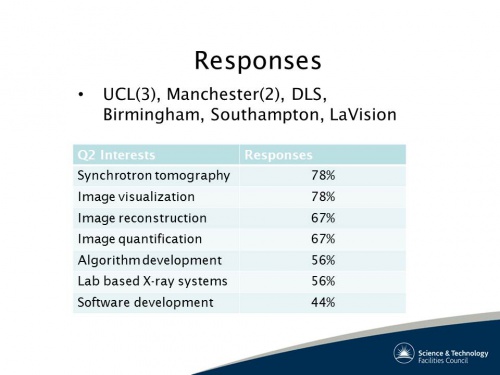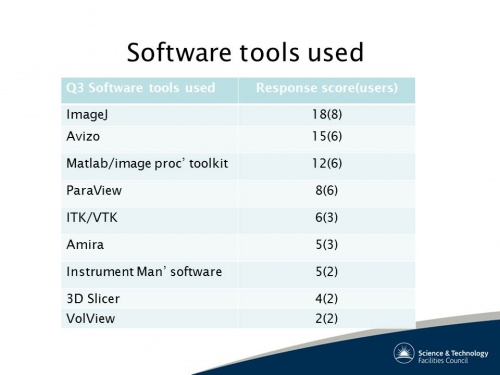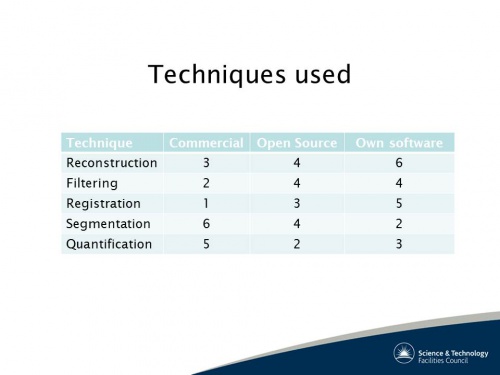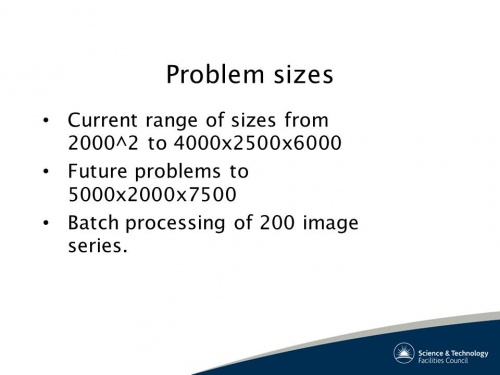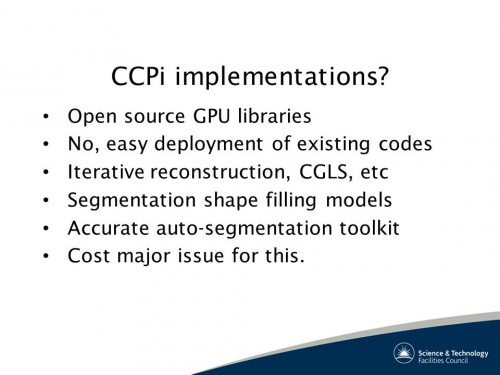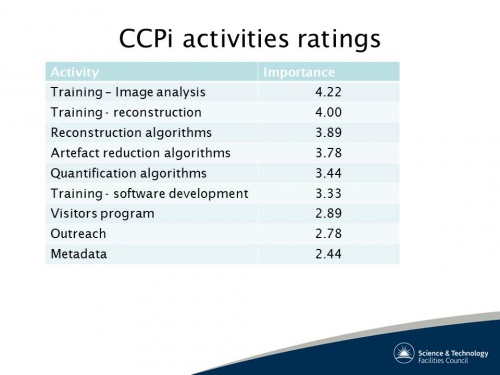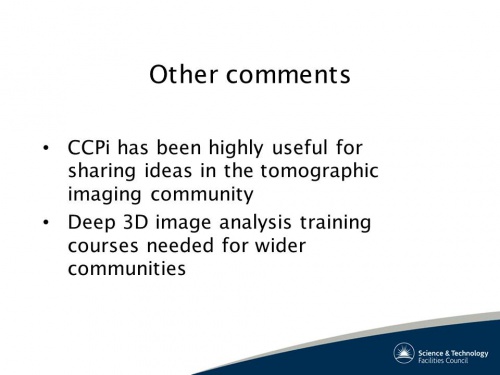CCPiSurvey
Contents
Collaborative Computational Project in Tomographic Imaging (CCPi) Survey results
This survey was carried out during March-June 2014 to influence the panel during the Summer Working Group meeting. The key aim was to discuss how limited CCP core SLA effort could be better utilised by focussing on specific API development for certain platforms. Two secondary aims were first to consider which visualisation tools would be implementable within a new framework that was being proposed for the CCP, and the other secondary aim was to ask for feedback on the non-programming development work that the CCP was carrying out; for example training, advice etc.
On 17 June 2014 the CCPi Working Group Meeting was held at the Atlas Visualisation Facility in RAL and the following presentation was given with feedback received to the CCP. Over the following six months to December 2014, progress has been focussed to address any issues and promote those areas that need enhancing.
Executive Summary
From this survey the focus on choice of tools was changes so that ImageJ, Avizo and ParaView products were favoured. A previous popular tool for development VolView proved to be unpopular for users and therefore was dropped.
The type of software development supported should focus primarily on the areas where the network already has skills that can be leveraged (reconstruction) with new partners sought to fill gaps (quantification and segmentation) for the future. Training was shown to be a requirement at different levels with outreach and metadata to be a lower priority.
Over the following six months changes have happened that have resulted in the following actions:
- Quantification visualisation tools are now being developed with API links for ImageJ, Avizo and ParaView; the most popular specific tools.
- Outreach events are continuing but at a lower effort level.
- Software show-and-tell events along with related seminars now aim to focus on guidance and use of the products as well as the research solution that is being solved. These are now becoming monthly events and also aim to keep a user and developer community connected.
- Increase in cross training sessions: there is a collaboration now across Diamond Light Source / RCaH / University of Manchester and SCD/STFC labs with links to the Harwell Imaging Partnership and ISIS (Neutron Spallation Source). Four annual training events are being held at DLS/RCaH and a further four annual training events at UoM with specialist events being held at SCD/STFC in RAL - all of these allow for cross-attendance throughout the CCPi network.
- The survey allowed for representation at celebration events; including the Queen's Anniversary Prize at Manchester and the ToScA exhibition space where we sponsor poster prizes.
- Quarterly Developers' Workshop days are now held in CCP remote institutions and focus on areas that the survey stated there were needs.
This was not just a useful test but resulted in real actions that were guided by responses, and a further survey on CFD and then a global survey were carried out over the Summer and early Autumn of 2014.
Presentation
Respondents came from a range of users through the 300+ names on the list but only 9 responded completely. The second question asked “What aspects of imaging are you involved with?” and gave a fixed set of responses.
This showed a predominance for user based needs rather than development needs; and also national facilities rather than lab based (often university type facilities) users.
Q3 "What software do you use for tomographic analysis and visualization?" With fixed list of tools.
This showed that there were a few key favoured packages that would be candidates for API links for future development.
Q4 "What image processing techniques do you use?" Choice of commercial/open source/own software.
This was interesting and significant, as it showed that users were developing their own software for reconstruction and some filtering techniques but mainly using commercial software for segmentation and quantification.
Q5: "What are your current and future computational requirements? Please detail your current needs in terms e.g. of image size and number of images. What computer hardware is typically required to process your data and is fast turn around important to your experiments?" Comments given were:
As expected scale and size of object was important although these values can be represented within large (1/2 TB RAM) fat nodes so extreme cluster implementations were not necessarily there to be developed.
Q6 "Are there any algorithms in tomographic image reconstruction, analysis or quantification that you believe CCPi should consider providing an efficient open source implementation of?" Comments given were:
This gave a starting point for a list of potential new objectives for the SLA team to address.
Q7 "CCPi is involved in a range of activities to support the research community (see http://www.cpi.ac.uk). Of the current CCPi activities which do you believe to be the most beneficial to the research community? Please rate each area on a scale of 1 to 5, with 5 being most important."
The obvious priority was training requirements - and discussion in the WG involved ways to set up cross training facilities and access to data.
Q8 "Do you have any other comments on the CCPi project?" Comments given were:
Results from Survey: July-December 2014
Over the following six months changes have happened that have resulted in the following actions, (with illustrations):
- Quantification visualisation tools are now being developed for ImageJ, Avizo and Paraview the most popular specific tools.
- Outreach events are continuing but at a lower effort level. This includes the Eurographics EuroVis conference
and different KTN Materials exhibitions that had significant attendance.
- Software show-and-tell events along with related seminars focus on guidance and use of the products as well as the research solution. These are now monthly events to keep a user and developer community connected. Last 18 events have posters with images; so for 2013 - 2014 season there have been the following events
and for 2014 - 2015 seasons we have so far had,
- Increase in cross training sessions: there is now a collaboration across Diamond Light Source / RCaH / University of Manchester and SCD/STFC labs with links to the Harwell Imaging Partnership and ISIS. Four annual training events are held at DLS/RCaH and four annual training events are held at UoM and specialist events are held at SCD/STFC in RAL all allowing for cross-attendance throughout the CCPi network. Last two specialist events were on 8 September 2014 with Ajay Limaya (CCPi Short-term fellowship) on Drishti 2.5 with a morning training session and a afternoon data analysis hands on session.
and 8 May 2014 an Avizo 'experts' workshop was held at RAL considering use of v8.1
- The survey allowed for representation at celebration events; including the Queen's Anniversary Prize at Manchester and the ToScA exhibition space where we sponsor poster prizes.
ToScA annual meetings:
- Quarterly Developers' Workshop days held in CCP remote institutions on various specific topics; Birmingham, Nottingham and QMUL.

